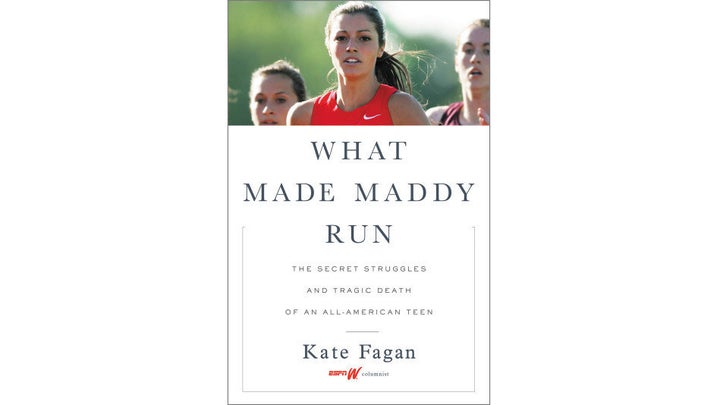
Editor’s note: This is an excerpt from Kate Fagan’s new book, What Made Maddy Run: The Secret Struggles and Tragic Death of an All-American Teen, in which she documents the haunting story of a top student and star athlete, Madison Holleran, who took her own life in her sophomore year of college. Fagan interweaves her reporting of Madison’s story with her discussions with current college students, as well as memories of her own collegiate athletic career and personal experiences with the forces that can overwhelm.
Crushing, debilitating anxiety has descended on me only once. I have battled everyday anxiety on occasions too numerous to count, whether before speaking in public, before going on TV, before offering an opinion in meetings. Yet during each of these occasions I understood, even as the weight of the fear commandeered a good portion of my brain and body, that the panic was temporary, circumstantial. The anxiety had a shelf life; of this I was sure.
But on one specific winter morning—the catalyst was the implosion of a relationship the night before—I awoke before dawn and, as I came to consciousness, experienced a blend of frenzied thinking and an overwhelming physical malaise that catapulted me into a state of panic. I tried breathing deeply, but my mind continued churning: What’s the point of all this? Who am I now? What does my future hold? Am I alone in the world? Will I always be alone? Aren’t we all, essentially, alone? I actually started talking aloud to myself, telling myself to calm down, that it would pass. But this self-talk failed. My heart continued racing, even though I hadn’t gotten out of bed yet—had barely even moved. I reached for an empty journal I keep on my nightstand; I tried to write my way out of the moment, believing that perhaps I could exorcise the thoughts, silence them by dragging them from my head to the paper, where they would wither and die in the open air. After writing furiously for seven pages, my handwriting slanted and messy, the ink blotting, I closed the journal and waited. I shut my eyes. The panic was still there. Is this feeling real? I asked myself. And do I have any control over it? It seemed as if I should have more control, for who could control it, who could make it go away, if not me?
I tried allowing the panic to just wash over me. Perhaps, I told myself, resisting the emotions was a mistake. Just feel it all, I told myself, then you’ll be done with it. For an hour I lay on my back, blankly staring at the white ceiling. At one point I curled up into a ball, hoping that anxiety was like nausea, and that mimicking life in the womb would ease the symptoms. Eventually I remember screaming into my hands, actually saying aloud, “What the fuck!”
The sun came up, and the city outside my window started making its usual noises: the F train running along the tracks, engines starting, the distant blaring of horns along the Brooklyn-Queens Expressway. I remember, prone in my bed, looking at these noises—or, rather, looking at the drawn off-white shade, behind which was the window, behind which was the world from which these noises were emanating. I usually love these sounds: they’re proof of ordered chaos, of life and hope and optimism. But that morning the noises struck me as random and pointless, and if I’d had the power, I would have silenced all of it. The dull yellow of the early morning sun had backlit the drawn shade, and the whole image, which I’d seen and appreciated a hundred mornings before, disgusted me. Not a minute later, as I lay on my side, my pillow tucked under my ear, a thought came screaming around the corner of my mind and ran me over before I could dodge it: Holy shit, I can’t live like this. “This” had been going on for only three hours, and it was scaring me; I was scaring me.
I called my mom. I started crying. She took the next train from Albany down to the city. She hugged me when I collected her at Penn Station. We walked to get coffee. I tried to explain what I was feeling, what had happened. Nothing, not even the comfort of my mom, could calm me. That night, hours later, we decided to go see a movie, and at some point in the darkness of the theater, I could feel the fear start to seep out of my body. I tried not to pay it much mind in case my attention might halt the flow, but by movie’s end I had returned to a state of equilibrium that I vowed never again to take for granted. And to this day, when I see the poster for the movie we went to see that night, a mix of emotions bubble up, but the dominant one is gratitude that this bout of panic lasted only twelve hours. (Over the next few weeks I had random bursts of anxiety, but never again did it seem to coil around my heart the way it did that first morning.)
I do not live with daily, steady anxiety and depression; therefore I cannot know what life feels like if you do. But I know this: Madison walked a path. And at first, the path she walked is familiar to me: the sun is high; the grass is matted; the underbrush is tame. I’ve walked that path, or something similar. Then, at some point, the conditions start to change; they become more ominous, denser, less traveled. Then, farther ahead, the path appears to shape-shift—it’s not subject to the same laws of physics, of life. I can peer ahead into the distance and see the outline of where Maddy walked, but I cannot report back from the inside. For most of us, understanding how much of this path we’ve traveled is impossible: it’s a road of unknown length.

Reprinted from What Made Maddy Run: The Secret Struggles and Tragic Death of an All-American Teen, by Kate Fagan. Copyright © 2017 by Kate Fagan. Published by Little, Brown and Company.
If you or someone you know needs help, call 800-273-8255 for the National Suicide Prevention Lifeline. You can also text “CONNECT” to 741741 to reach counselors from the Crisis Text Line.